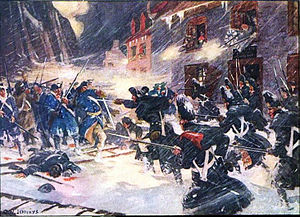The Battle of Quebec was fought between the Continental Army and British defenders of Quebec on December 31, 1775. Although a major defeat for the Americans, it showed the dogged determinism of American commander Benedict Arnold, who showed his bravery in the Battle of Saratoga before defecting to the British.
The Battle of Quebec marked the end of American offensive operations in Canada. General Richard Montgomery was killed, Arnold wounded, and Daniel Morgan and more than four hundred American soldiers taken prisoner. Returning forces of the Continental Army arrived ragged and nearly starved.
Battle of Quebec Background: Montgomery’s Expedition
-
- Canada had belonged to France until the French and Indian War. In the Treaty of Paris (1763) which ended the war, France ceded Canada to the British.
- Canada had been generally peaceful and stable under the governorship of Sir Guy Carleton, who governed it from 1768-88.
- In May 1775, the Continental Congress had issued a call to the residents of Canada to join the revolution, but they declined.
- At the same time, Congress appointed Philip Schuyler as commander of the Northern Department and told him to plan an invasion of Canada. Due to his poor health, Schuyler delegated leadership of the attack to General Richard Montgomery.
- In August, Montgomery took 1200 men and several boats and marched up Lake Champlain and the Richelieu River to Fort St. John, just across the St. Lawrence River from Quebec. He launched two assaults on the fort, but neither succeeded. He then laid siege to the fort.
- In November, the fort surrendered to Montgomery. Half of the entire British regular army of Canada were now prisoners, and the road to Montreal was clear.
Arnold’s Expedition and the Battle of Quebec
-
- In mid-June, Benedict Arnold proposed a plan to Congress in which he would rally the habitants (French speakers, some of whom were not happy being under British rule) to his flag, and then take Montreal and Quebec. Congress approved the plan, as did Washington. Congress paid Arnold back for about 2/3 of his expenses from the Ticonderoga campaign.
- Arnold and his soldiers (which included a company of Virginia riflemen led by Daniel Morgan) would sail to the mouth of the Kennebec River (in modern-day Maine), then move up the Kennebec, transferring to the Chaudiere River, then moving up it straight to Quebec. Carleton would have to move troops from Montreal or leave Quebec undefended.
- On the way, the Continentals encountered heavy rain, an early frost, and a hostile wilderness. Also, their maps were inaccurate.
- Boats had to be carried, food ran low, shoes wore out, and one battalion simply quit and left. Some of the boats were very poor quality and leaked.
- After 51 days, On November 8, Arnold finally reached the city to prepare for the Battle of Quebec. One of Arnold’s soldiers wrote “It was the most prodigious march ever accomplished by man.”
- Quebec only had 7 cannon and a few hundred second-rate guards. But Arnold, with only 650 men, decided to rest his exhausted soldiers.
- While the Americans were resting, several hundred British or allied troops arrived to reinforce the city.
- Arnold and his men crossed the St. Lawrence, scaled the cliffs and assembled at the Plains of Abraham. He demanded the city’s surrender three times, but the British commander refused.
- On November 18, Arnold gave up the siege, moved 20 miles upstream toward Montreal, and decided to wait for Montgomery to arrive and reinforce him before attacking.
- On November 11, Carleton ordered Montreal abandoned. He went downriver toward Quebec. Along the way, he encountered a group of colonials who demanded his surrender. He escaped (in disguise) and eventually reached Quebec, where he took command.
The Battle of Quebec
-
- Montgomery finally arrived on December 1, but with only about 500 men. Montgomery and Arnold tried to lay siege in the Battle of Quebec with a combined force of about 1100. The British, under Carleton, had about 1800 soldiers.
- On December 31, they decided to assault the town under cover of a snowstorm. They broke into the weakest part of the city, the Lower Town. Daniel Morgan’s riflemen played a key role in the attack.
- The Americans could not penetrate the heavier defenses of the Upper Town. Many Americans, including Morgan, were trapped and surrendered.
- Montgomery was killed and Arnold was seriously wounded. The Patriots suffered about 450 casualties (50 killed or wounded and 400 captured, one-fourth of whom later changed sides). The British took perhaps 40 casualties.
- Arnold pulled back and resumed the siege, but he had to leave the army behind due to his leg injury.
- On March 4, 1776, a British fleet brought 7000 reinforcements under General John Burgoyne to Quebec to prepare for the Battle of Quebec. Arnold retreated upriver to Montreal. During the retreat, many of the Patriot force died of smallpox. All suffered from hunger and had to raid farms of habitants, which alienated them from the Patriot cause.
- Then Carlton went on the offensive.
- In early June, Carlton fought off an American counterattack. Arnold evacuated Montreal, with Carlton constantly hitting him from behind, and moved to Fort St. John.
- The Patriots, now under the command of John Sullivan, retreated from Fort St. John. Sullivan wrote “I found myself at the head of a dispirited Army, filled with horror at the thought of seeing their enemy…Smallpox, famine and disorder had rendered them almost lifeless.” A Patriot soldier wrote “Lice and Maggots were creeping in Millions over the Victims.”
- Carlton ordered the building of a fleet that was to sail down Lake Champlain deep into American territory toward Ft. Ticonderoga.
- Carlton was stopped at Valcour Island by 13 American gunboats under Arnold’s command. He retreated back to Montreal.
- The Patriot army staggered into Fort Ticonderoga. John Adams described them as “disgraced, defeated, discontented, diseased, naked, undisciplined, [and] eaten up with vermin.”
- By the end of the Battle of Quebec campaign, the Patriots had suffered 5000 total casualties. Americans would never again attack Canada in the Revolutionary War).
This article is part of our larger selection of posts about the Revolutionary War. To learn more, click here for our comprehensive guide to Revolutionary War.
Additional Resources About Revolution and Colonies
Cite This Article
"The Battle of Quebec" History on the Net© 2000-2024, Salem Media.
April 20, 2024 <https://www.historyonthenet.com/battle-of-quebec>
More Citation Information.







